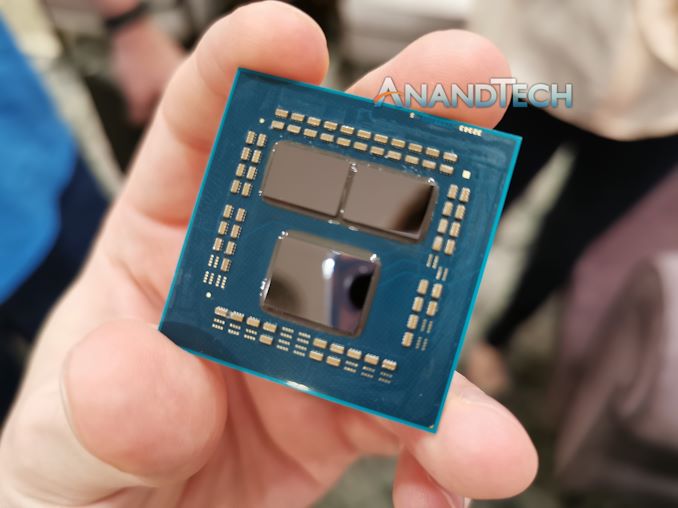Reaching for Turbo: Aligning Perception with AMD’s Frequency Metrics
by Dr. Ian Cutress on September 17, 2019 10:00 AM EST
For those that keep a close eye on consumer hardware, AMD recently has been involved in a minor uproar with some of its most vocal advocates about the newest Ryzen 3000 processors. Some users are reporting turbo frequencies much lower than advertised, and a number of conflicting AMD partner posts have generated a good deal of confusion. AMD has since posted an update identifying an issue and offering a fix, but part of all of this comes down to what turbo means and how AMD processors differ from Intel. We’ve been living on Intel’s definitions of perceived standards for over a decade, so it’s a hard nut to crack if everyone assumes there can be no deviation from what we’re used to. In this article, we’re diving at those perceived norms, to shed some light on how these processors work.
A Bit of Context
Since the launch of Zen 2 and the Ryzen 3000 series, depending on which media outlet you talk to, there has been a peak turbo issue with the new hardware. This turbo frequency issue has been permeating in the ecosystem since Zen 2 was launched, with popular outlets like Gamers Nexus noting that on certain chips, the advertised turbo frequency was only achieved under extreme cooling conditions. For other outlets, being within 50 MHz of the peak turbo frequency has been considered chip-to-chip variation, or a function of early beta firmware. A wide array of people put varying amounts of weight behind this, from conspiracy to not being bothered about it at all.
However, given recent articles by some press, as well as some excellent write-ups by Paul Alcorn over at Tom’s Hardware*, we saw that the assumed public definitions of processor performance actually differs from Intel to AMD. What we used as the default standard definitions, which are based on Intel’s definitions, are not the same under AMD, which is confusing everyone. No one likes a change to the status quo, and even with articles out there offering a great breakdown of what's going on, a lot of the general enthusiast base is still trying to catch up to all of the changes.
This confusion – and the turbo frequency discussion in general – were then brought to the fore of news in the beginning of September 2019. AMD, in a two week span, had several things happen essentially all at once.
- Popular YouTuber der8aur performed a public poll of frequency reporting that had AMD in a very bad light, with some users over 200 MHz down on turbo frequency,
- The company settled for $12.1m in a lawsuit about marketing Bulldozer CPUs,
- Intel made some seriously scathing remarks about AMD performance at a trade show,
- AMD’s Enterprise marketing being comically unaware of how its materials would be interpreted.
Combined with all of the drama that the computing industry can be known for – and the desire for an immediate explanation, even before the full facts were in – made for a historically bad week for AMD. Of course, we’ve reported on some of these issues, such as the lawsuit because they are interesting factoids to share. Others we ignored, such as (4) for a failure to see anything other than an honest mistake given how we know the individuals behind the issues, or the fact that we didn’t report on (3) because it just wasn’t worth drawing attention to it.
What has driven the discussion about peak turbo has come to head because of (1). Der8auer’s public poll, taken from a variety of users with different chips, different motherboards, different cooling solutions, different BIOS versions, still showed a real-world use case of fewer than 6% of 3900X users were able to achieve AMD’s advertised turbo frequency. Any way you slice it, without context, that number sounds bad.
Meanwhile, in between this data coming out and AMD’s eventual response, a couple of contextual discrepancies happened between AMD’s partner employees and experts in the field via forum posts. This greatly exacerbated the issue, particularly among the vocal members of the community. We’ll go into detail on those later.
AMD’s response, on September 10th, was a new version of its firmware, called AGESA 1003-ABBA. This was released along with blog post that detailed that a minor firmware issue was showing 25-50 MHz drop in turbo frequency was now fixed.
Naturally, that doesn’t help users who are down 300 MHz, but it does come down to how much the user understands how AMD’s hardware works. This article is designed to shed some light on the timeline here, as well as how to understand a few nuances of AMD's turbo tech, which are different to what the public has come to understand from Intel’s use of specific terms over the last decade.
*Paul’s articles on this topic are well worth a read:
Ryzen 3000, Not All Cores Are Created Equal
Investigating Intel’s Claims About Ryzen Reliability
Testing the Ryzen 3000 Boost BIOS Fix
This Article
In this article we will cover:
- Intel’s Definition of Turbo
- AMD’s Definition of Turbo
- Why AMD is Binning Differently to Intel, relating to Turbo and OC
- A Timeline of AMD’s Ryzen 3000 Turbo Reporting
- How to Even Detect Turbo Frequencies
- AMD's Fix











144 Comments
View All Comments
peevee - Friday, September 20, 2019 - link
Sunny Cove is about just as new as Zen2 compared to Zen+, if not more.Only not "architecture" but "microarchitecture", architecture is the same Von Neumann prevalent since 1940s, or its Harvard variant prevalent since 1980s.
Jovec - Tuesday, September 17, 2019 - link
Might go to credibility and past behavior. Bulldozer couldn't maintain stock speeds under load (although the lawsuit was for something else IIRC).evilspoons - Tuesday, September 17, 2019 - link
Thanks for the informative article. The modal frequency being so close to the rating on all those 3000-series chips, BEFORE the +25-50 MHz fix, means it's not even worth worrying about. As consumers it's good to be informed and keep an eye on the companies we buy from, but there's no conspiracy here. Just confusion.Karmena - Wednesday, September 18, 2019 - link
Companies have to be held accountable on what they write on the boxes. Even if that is off by 25 out of 4400. Just be honest and write 4375.Atari2600 - Wednesday, September 18, 2019 - link
I'm sure your bright enough to be able to round up to 1 decimal place.What does 4.375 become when rounded to 1 decimal place?
ianisiam - Wednesday, September 18, 2019 - link
Except for the fact that 4400 isn't guaranteed. Like evilspoons said, it's just confusion.eva02langley - Wednesday, September 18, 2019 - link
You didn`t read the article obviously... these are not guaranteed. If you apply thermal paste and HSF pressure like an amateur, your results will not be in line with AMD numbers, but of course you will scream rip-off...Karmena - Monday, September 23, 2019 - link
Will not scream, just it would be nice to have every little bit. With ABBA, that is the case, in the end I need good mobo, good cooling, some memory OC prooves and I do not have to worry about CPU OC as that is brought to maximum performance by itself already.limitedaccess - Tuesday, September 17, 2019 - link
I feel there is one more aspect to this that wasn't fully addressed nor have seen it very addressed in discussions.According to your article (which matches previous understanding) is that Intel (even if they won't guarantee it the boost speeds) will bin CPUs so that every core is capable of running at the listed turbo speeds. In your example every core can reach 4.6ghz for the 9600k.
While AMD with Zen is only binning one core as capable of reaching the boost speeds. Although you list a more likely typical example in your article does this not in theory mean that a 3600x which can only reach 4.4ghz on a single core, while all other 7 can only hit 3.8ghz will pass (even if statistically such a CPU is extremely unlikely)? Or is their binning actually tighter then this but not disclosed anywhere?
This has been one of my concerns with respect the this type of situation going forward. It seems like there needs to be more disclosure/data points on binning requirements going forward.
ajlueke - Tuesday, September 17, 2019 - link
Thanks Ian!Could you highlight what the nebulous "limits of the silicon" are? I have noticed, that in low current (core) work loads with Zen 2, the performance seems to be fixed. I'm not reaching any temperature, EDC, TDC or PPT boundary, but changing the scalar, increasing fmax, or increasing the aforementioned limits. It seems something else is limiting the processor's ability to boost, but there is no clear indication what that is. I have observed the Stilt mention the Fitness Monitoring Tool (FIT) as a voltage limit baked into the silicon. Zen 2, tend to be at this limit, and it simply will not go higher regardless of what you set PPT, TDC and EDC at. Do you have any additional information on this limiter?
It does seem fundamentally different for overclockers. The voltage limit on boosting seems to be reached before thermal limits, meaning that Zen2 CPUs with the stock cooler boost the same as those with far better heat dissipation, at least in lightly threaded workloads. I guess this is a good thing for users overall, as everyone gets the same performance out of the box, but jarring for enthusiasts who are used to seeing much high numbers on their systems. I noticed the delta between the bottom 5th percentile and upper 95th percentile of the 3900X on userbenchmark was 12.4%. Incredibly tight, and demonstrates that there likely isn't much to ring out of these systems.